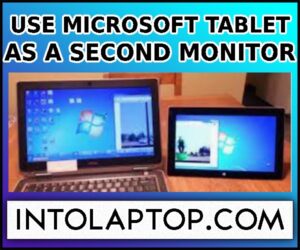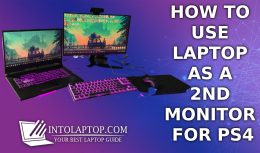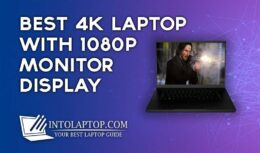Are you looking for details about How to use Microsoft tablet as Second Monitor via Miracast?
Then you are at the right place.
Read this article for instructions about the same.
How to use Microsoft Tablet as Second Monitor via Miracast – 10 Steps
If you’ve ever found yourself wishing you had a second monitor while working on your computer, you’re in luck.
A Microsoft tablet can be used as a second monitor, and it’s actually pretty easy to set up.
Microsoft’s Surface line of tablets can be used as a second monitor for your PC using the wireless display standard known as Miracast.
Here’s how to set it up.
To use your Surface as a second monitor, you’ll need to have a Miracast-capable receiver plugged into your PC.
Any Windows 8.1 or 10 PC should have this capability built-in; for older PCs, you’ll need to buy a Miracast receiver like the Microsoft Wireless Display Adapter.
Miracast is a wireless technology that allows you to connect your device to a display without using any cables.
To use your tablet as a second monitor, you’ll need to connect it to your PC using a Miracast.
Once you’ve done that, you’ll be able to use your tablet as a second monitor just like you would with a regular monitor.
Also Read: BEST TOUCH SCREEN PORTABLE MONITORS
1. 10 Steps to Follow on How To Use Microsoft Tablet As Second Monitor via Miracast
- Go to settings
- Tap or click PC and devices, and then tap or click Project to this PC.
- Do one of the following:
- If the Project to this PC settings is turned off, tap or click the slider to turn them on.
- If the Project to this PC settings is turned on, tap or click Available everywhere or Available everywhere on secure networks, depending on your needs.
- Tap or click Confirm.
- Open the Action Center.
- Type Connect in the search box, and then tap or click Connect.
- Select the projector or receiver that you want to project to.
- If you’re prompted, do one of the following:
- If you want to allow other people to project to your PC without having to enter a PIN each time, tap or click Yes.
- If you don’t want to enter a PIN each time you project, select the don’t ask me again for other devices check box, and then tap or click Yes.
- When the connection is made, the Projector Connected notification appears.
- To stop projecting to the projector, click Disconnect.
Also Read: LAPTOPS THAT SUPPORT EXTERNAL 4K MONITORS
2. Benefits of using a Tablet as a Second Monitor
Tablets are becoming increasingly popular as second monitors because of their portability and convenience.
Here are some benefits of using a tablet as a second monitor:
1. You can take your tablet with you wherever you go.
2. Tablet screens are usually high-resolution, so you’ll get a crisp, clear picture.
3. Most tablets have built-in speakers, so you won’t need to carry extra audio equipment.
4. A tablet can be a great way to show off your work to clients or colleagues.
3. Tips and Tricks for using your Microsoft tablet as a Second Monitor
If you’re looking to get the most out of your Microsoft tablet as a second monitor, here are a few tips and tricks to keep in mind.
Ensure both your tablet and your PC are connected to the very same Wi-Fi network.
This will ensure that the tablet receives the optimal signal strength for streaming.
Next, open the Connect app on your PC and select your Microsoft tablet from the available devices list.
After you connected, you’ll be able to choose how your tablet’s screen is used.
For example, you can have it mirror your PC’s display or extend your desktop.
If you want to use your tablet as a touch-enabled monitor, be sure to enable the touch feature in the Connect app’s settings.
This will allow you to use your finger or a stylus to interact with applications on your PC.
And finally, keep in mind that the resolution of your Microsoft tablet may not be as high as your PC’s native display.
So, if you’re working with high-resolution images or video, you may want to consider connecting an external display to your PC.
Also Read: BEST CURVED GAMING MONITORS FOR LAPTOP
4. How to Make the Most Out of a Second Monitor
A second monitor can be a great asset for any computer user.
With an extra screen, you can increase your productivity by having more space to work with.
Here are a few tips on how to get the most out of your second monitor:
Make sure that your second monitor is placed at a comfortable viewing height.
This will help reduce neck and eye strain.
Use your second monitor to display information that complements what you’re working on your primary monitor.
For instance, if you’re working on a document, you can have your email open on your second monitor.
This way, you can easily reference any information you need without having to alt-tab between programs.
Take advantage of your second monitor’s extra space by utilizing productivity tools such as Windows’ snapping feature.
This allows you to easily move windows around and organize your workflow.
If you often find yourself working between different programs, an extra monitor can make it easier to keep track of everything.
You can have one program on your main screen, and another on your second monitor.
This can help you be more productive and avoid losing your place.
If you’re working with a lot of data, an extra monitor can also help you keep track of it all.
You can have one screen for your data entry and another for your analysis.
This can help you work more efficiently and avoid making mistakes.
An extra monitor can also be helpful if you need to reference something often.
For example, if you’re writing a paper, you can have your research on one screen and your document on another.
This can save you time by reducing the need to switch between different programs or tabs.
Finally, an extra monitor can simply give you more space to work.
If you find your main screen feels cramped, an extra monitor can give you the breathing room you need to be more productive.
Whether you’re working from home or in an office, an extra monitor can be a valuable tool.
By considering how you can use an extra monitor, you can maximize its potential and boost your productivity.
If you want to be more productive, utilizing a second monitor is a great way to do so.
By having more space to work with, you can easily organize your work and have all the information you need right in front of you.
Plus, with a second monitor, you can easily reference other materials while you work on something else.
This can be a major time-saver and help you get your work done more efficiently.
You can become more efficient
If you’re using a laptop, you can increase your efficiency by connecting it to a second monitor. Once you have a second monitor set up, you can use it to display different kinds of information.
You can also use your second monitor to display a larger version of the same document or file you’re working on. This can be helpful when you’re working with spreadsheets or long documents.
By having a larger view of your work, you can avoid scrolling back and forth between different sections.
You can also use your second monitor to keep an eye on social media or other websites while you work.
This can be a great way to stay up-to-date on current events or developments in your field without getting distracted from your work.
Just be sure to set up some rules for yourself so that you don’t get too sidetracked. For example, you might only allow yourself to check social media sites on your second monitor during specific breaks.
You can save time
If you frequently find yourself working with multiple programs at once or working on projects that require reference materials, then a second monitor can be a lifesaver.
By dedicating one screen to your work and another to your reference materials, you can avoid the time-consuming task of constantly switching between tabs or windows.
This can help you work more efficiently and avoid distractions.
Another way to make the most out of a second monitor is to use it for personalization.
You can set up a custom wallpaper or photo gallery, or use it to display information that is important to you.
For example, you can add a calendar or clock to your second monitor so that you can easily see what time it is or how much time you have left to work on a project.
You can also use your second monitor to create a custom workspace that is tailored to your needs and preferences.
You can have more fun
With a second monitor, you can have more fun by being able to do more things at once.
For example, you can have a movie playing on one screen while you chat with friends on the other. Or you can keep an eye on your email while you’re working on a project.
Having a second monitor can make multi-tasking more fun and efficient.
A second monitor can be a great addition to boost productivity, but only when used correctly.
Utilize these tips to get the most out of a second monitor and see just how much more productive you can be.
Also Read: BEST 4K LAPTOP WITH 1080P MONITOR DISPLAY
Conclusion about How To Use Microsoft Tablet As Second Monitor
Hope you got an idea about How To Use Microsoft Tablet As Second Monitor.
If you have ever wished you could have a second monitor for your computer, but don’t want to invest in the hardware, Microsoft has a solution.
Using their Miracast technology, you can beam your tablet’s screen to your computer as a second monitor.
Also, you can explore intolaptop.com to find out more laptops.
Incase if you have more queries about this article “How To Use Microsoft Tablet As Second Monitor” then please drop a comment below in the comment box.
LAPTOP BUYING GUIDE 2024
|
- 10 Best Laptop for Laser Engraving AMD Intel 2025 - March 9, 2024
- 11 Best Laptop for Mechanics Intel AMD 2025 - March 9, 2024
- 12 Best Laptops for Tattoo Artists 2025 - March 7, 2024



